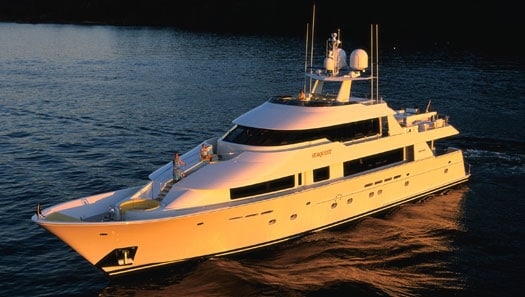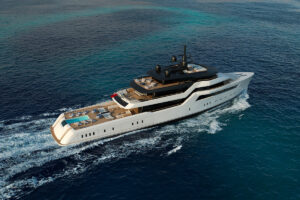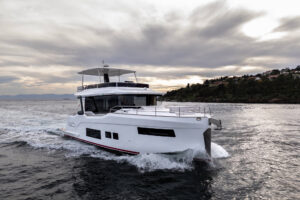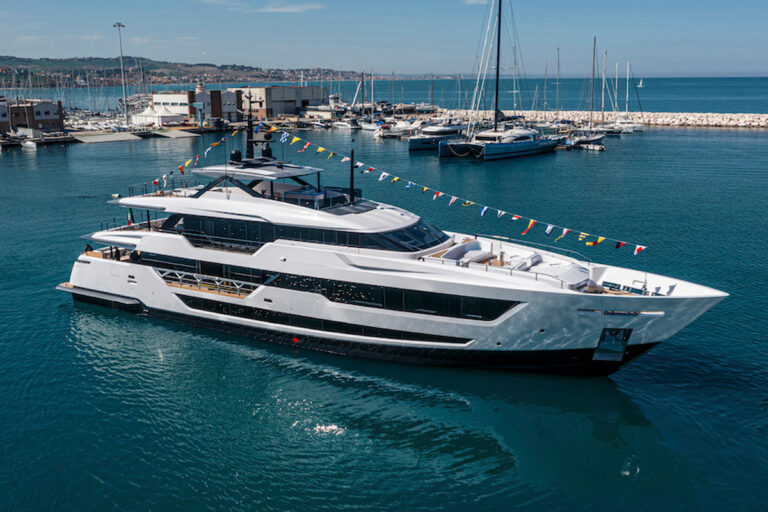
yachting/images/magazine/2005/112005/fea_westport_525x297.jpg
At a recent boat show, I joined an acquaintance and his captain as they toured a Westport 112-foot motoryacht. It was one of the yachts on the short list for a planned move up from a 74-foot production yacht. From 74 to 112 can be quite a step in cost, complexity and complications, and I’ve seen more than a few owners reconsider such a significant upgrade after fully evaluating the pros and cons. In this case, though, I was struck by the owner’s immediate comfort level with the bigger vessel. The Westport 112 was much larger, to be sure, but it did not overwhelm him. He could visualize his family and friends aboard, enjoying the extra space without having to change their lifestyle.
A Westport 130-footer was moored alongside, so we took in that yacht as well, and I found the reaction of my acquaintance and his captain interesting. Not only was the step from 74 feet to 112 something they considered quite doable, but they both speculated on moving to the 130 after a few years with the 112. That, in a nutshell, is the story of another owner, an American who recently took delivery of Seaquest, the latest 130-foot motoryacht from Westport Shipyard, after a previous move into a Westport 112 from a string of earlier yachts. Further easing the owner’s transition was the fact that his 112 was sold within two weeks of becoming available on the very competitive brokerage market.
Seaquest brings to an even dozen the number of 130-footers Westport has delivered. The yard is having a record year, with six deliveries to date and four more scheduled before year’s end from its line of 98-, 112- and 130-foot semi-production yachts. The two smaller models are raised-pilothouse configurations, whereas the flagship 130 is a full trideck.
Yachts are evolutionary products. Each new build benefits from the experience her designer and builder have gained from prior yachts, and in the case of Seaquest, the benefit is considerable. Her naval architect is Bill Garden, whose portfolio is bulging with both sailboats and powercraft of considerable renown. You need only one glance at Seaquest under way to know that her hull form is an especially efficient one. The narrow angle of her bow cuts the water cleanly with a noticeable lack of fuss, and her wake is as minimal as possible given her size and displacement.
It’s something Garden honed to perfection on years of sailing-hull designs and brings to his motoryacht designs with aplomb. The fine lines forward mean the crew quarters are pushed aft a bit farther than normal, putting the guest accommodations near the yacht’s center of pitch for added guest comfort. It also results in the deep fuel tanks, which separate the engine room’s noise and heat from the guest staterooms, sitting near the hull’s longitudinal center of flotation, so trim will change very little as fuel is burned off. The fuel tanks are aluminum, as are the water tanks. The latter are epoxy coated inside for corrosion protection, and the holding tanks are constructed of fiberglass for the same reason.
Seaquest’s styling and arrangement are from the board of Greg Marshall, like Garden a veteran designer in the Pacific Northwest. To achieve the economic benefits of semi-production in large yachts that are more often custom built, a designer must stick to what has proven to be most popular with owners. Marshall’s design of the Westport 130 could serve as an archetype for the genre.
The arrangement has four en suite guest staterooms below deck, two with twin berths and two VIPs with queens. Crew quarters are forward, with an engineer’s cabin aft adjacent to the engine room. An engineer’s control room is built into the forward end of the engine room, and the engine room and its twin MTU 12V4000s are accessible via a protected stair from the aft deck as well as through a transom door for use in port or at anchor.
The master suite is situated forward on the main deck. In addition to the sleeping quarters, with a California king berth, there’s a his-and-hers bath with both a large shower and a spacious whirlpool tub. A huge walk-in locker sits just aft to starboard, leaving plenty of space in the main room for an attractive desk/vanity and settee.
Seaquest’s main entry foyer is to starboard and includes a day head, convenient for arriving guests, yet separated slightly from the dining area and saloon. The galley, to port of the foyer, has a generously sized dinette for informal guest dining; a separate crew lounge is located below. The dining area is divided from the saloon by low cabinets and a pair of columns, creating a sense of separation while retaining the feeling of one large room.
Abaft the saloon is a quintessential after deck, with a dining table, bar, transom seating and twin stairs to the swim platform. There’s also a spiral stair to the after end of the bridge deck, where a 17-foot Novurania tender rests, ready for davit launch. A spa and outside seating adjoin the tender stowage area aft, and forward, the Portuguese bridge is split by a central walkway to the foredeck where there’s a spacious circular guest lounge. Amidships is the pilothouse and upper deck lounge, with another bar and day head. Wing controls are fitted outboard of the pilothouse so the flying-bridge deck can be fully devoted to guest lounges and tables.
With a foundation of excellent designs from Garden and Marshall, Westport takes the evolution of Seaquest to fruition in fiberglass. Both the hull and superstructure are of composite construction, with blister-resistant gelcoat on the hull bottom and Awlgrip polyurethane above the waterline. Airex foam core is used to develop the necessary panel stiffness without carrying excess structural weight, and the hull stringers are cored as well. The standard equipment list is extensive and of first quality, with such items as Pool anchors, Freeman hardware, Maxwell windlasses and capstans and Northern Lights generators. Engines are fitted atop the fiberglass stringers with resilient mounts to reduce noise and vibration. Auxiliary machinery is likewise soft-mounted, and considerable attention is paid to placement of insulation for further sound reduction throughout the accommodations. Delivery is nearly turnkey, with everything from dinnerware to docklines included.
In addition to the three yacht models it is currently offering, Westport has a rich history of vessel construction. In the 41 years since the company’s founding in 1964, it has built over 50 complete yachts, 79 bare hulls for other builders, 170 commercial fishing boats and 35 commercial passenger vessels. The company has expanded from its original shipyard in Westport, Washington, taking in three additional facilities around the state for a total of 347,000 enclosed square feet, with over 500 employees.
Westport has recently begun construction of its most ambitious project to date, a 164-foot motoryacht. The yacht was jointly designed by Donald Starkey and Westport personnel, and will feature a six-stateroom layout. There are four staterooms below deck, a master suite on the main deck and a VIP suite on the upper deck.
Contact: Westport Yachts, (954) 316-6364; www.westport-yachts.com









